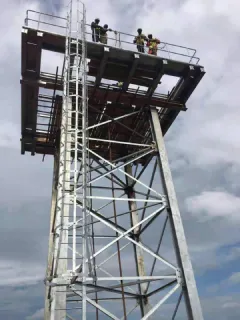loading...
- No. 9, Xingyuan South Street, Dongwaihuan Road, Zaoqiang County, Hengshui, Hebei, China
- admin@zjcomposites.com
- +86 15097380338
- Welcome to visit our website!
Exploring the Applications and Benefits of FRP C Channel in Modern Construction
Understanding the Importance of FRP C Channels in Modern Construction
In contemporary construction and engineering practices, the utilization of Fiber Reinforced Polymer (FRP) materials has gained significant traction. Among the various forms of FRP products, the FRP C channel stands out due to its unique properties and versatility. Today, we will explore the characteristics, benefits, and applications of FRP C channels and why they are becoming increasingly popular in various industries.
What are FRP C Channels?
FRP C channels are structural components made from reinforcing fibers, usually glass or carbon, that are embedded in a polymer matrix. This composite material is designed to provide high strength-to-weight ratios, exceptional durability, and resistance to environmental factors such as corrosion and chemical exposure. The C in C channels refers to their shape; these channels are shaped like the letter C, making them ideal for various structural applications.
Key Characteristics
1. Lightweight One of the primary advantages of FRP C channels is their lightweight nature. Compared to traditional materials like steel, FRP C channels are considerably lighter, which simplifies transportation and installation processes. This characteristic is particularly beneficial in projects where weight constraints are crucial, such as in bridge construction and retrofitting existing structures.
2. Corrosion Resistance Unlike steel, FRP materials do not rust or corrode when exposed to harsh environments. This property significantly increases the lifespan of structures that utilize FRP C channels, especially in applications exposed to moisture, chemicals, or saline environments.
3. High Strength-to-Weight Ratio FRP C channels possess a superior strength-to-weight ratio, which allows them to carry substantial loads without the added weight of traditional materials. This attribute makes them an attractive option for constructing lightweight prefabricated structures and components.
4. Flexibility in Design FRP C channels can be manufactured in various sizes, shapes, and colors, offering flexibility in design. This capability allows engineers and architects to utilize them in creative and innovative ways, accommodating specific project requirements and aesthetic preferences.
Benefits of Using FRP C Channels
The integration of FRP C channels in construction projects provides various benefits
frp c channel

1. Reduced Maintenance Costs Due to their corrosion resistance, structures using FRP C channels require less maintenance compared to those made from traditional materials. Lower maintenance needs translate to reduced operational costs over the lifespan of the structure.
2. Enhanced Safety The lightweight nature of FRP C channels contributes to safer installation processes. Workers can handle and install these materials with less physical strain and risk of injury.
3. Sustainability With growing emphasis on sustainable construction practices, FRP materials are often viewed as environmentally friendly. They sidestep the issues associated with metal mining and production, and many FRP products are recyclable.
4. Versatility in Applications FRP C channels find applications across various sectors, including marine, construction, infrastructure, and transportation. They are utilized in applications ranging from structural framing and support systems to equipment housings and walkways.
Applications of FRP C Channels
1. Infrastructure FRP C channels are extensively used in bridges, railings, and staircases. Their resistance to corrosion makes them an ideal choice for structures exposed to water and chemicals.
2. Industrial Settings Their lightweight and durable nature makes FRP C channels suitable for use in manufacturing plants and facilities where chemical resistance and safety are paramount.
3. Marine Environments In marine construction, FRP C channels provide structural support for docks and marinas due to their ability to withstand harsh saltwater conditions.
4. Building Construction Architects increasingly incorporate FRP C channels into building designs, allowing for innovative architectural features that maintain strength while reducing overall weight.
Conclusion
The adoption of FRP C channels in modern construction represents a significant advancement in materials technology. With their lightweight nature, exceptional corrosion resistance, and versatility, these channels offer a compelling alternative to traditional construction materials. As industries continue to prioritize sustainability and efficiency, the importance of FRP C channels will likely grow, paving the way for innovative applications and a more sustainable future in construction.
-
The Power of Filter VesselsNewsMay.19,2025
-
The Benefits of FRP WalkwaysNewsMay.19,2025
-
The Benefits of FRP Vessels: 1054 FRP VesselNewsMay.19,2025
-
FRP Pressure Vessels: Leading the Way in Innovation and ReliabilityNewsMay.19,2025
-
Explore the Benefits of FRP Grating for Your Industrial NeedsNewsMay.19,2025
-
Discover the Advantages of GRP GratingsNewsMay.19,2025
-
Revolutionary Modular Handrail Systems Redefine Safety StandardsNewsMay.15,2025
